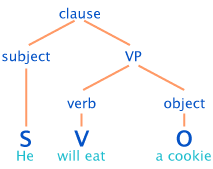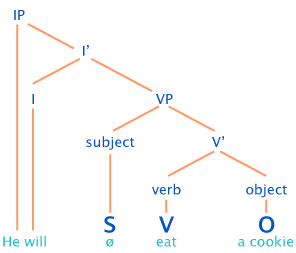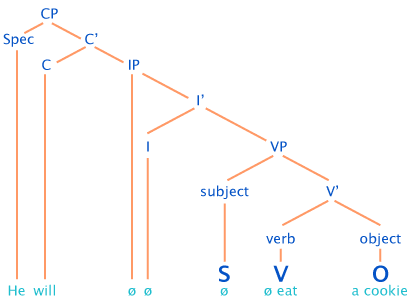
The Dutch sentence ‘Hij gaat een koekje eten’ translates as ‘he is going to eat a cookie’. In this example we will work with the sentence ‘he will eat a cookie’ because it is easier.
First let’s identify the components we have to work with:
subject: He
object: a cookie
verb(s): will, eat
First we should enter the subject, object and verb in the underlying structure of English. We know this is SVO (Diagram 1):

The finite verb needs inflection, therefore we need to add an IP. The English IP is head-initial, just like the English VP (Dutch VP and IP are head-final).
A head-initial IP looks like this (Diagram 2):
|
A head-final IP looks like this (Diagram 3):
|

Notice that even though ‘will’ in STEP 1 sounds the same as ‘will’ in STEP 2, we do mean the inflected form. If the only verb would be ‘eat’ in this clause, it would change its form to ‘eats’ which you can see is inflected. It is assumed that even though you cannot hear it, ‘will’ is also inflected (it would make no sense to have different types of verbs, types that can and types that cannot carry inflection).
Step 3 isn’t really necessary in English. The word order in STEP 2 is already correct so we need not stipulate positions where the verb can move. Just to be complete, this is what that tree would look like (Diagram 5):

Because movement to CP is unnecessary we assume that this is not the correct tree of English. The structure only needs to be built as far as the IP.
(In fact, many linguists claim that in English V does not move to I, but I moves to V. This means that STEP 2 is still necessary (we do need inflection) but the verb stays in its place and the inflection moves ‘down’ to the verb).